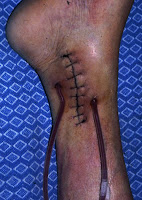The obstacles started to fall in 1960
On the 9th March 1960, Clyde Shields, a Boeing machinist in Seattle, was started on haemodialysis despite having chronic kidney failure. He was the first long-term dialysis patient and the beginning of a revolution. He survived with transplant until 1971, but he is unlikely to have suspected at the outset that he could have been beginning such a remarkable chapter of medical progress.
Belding Scribner, his renal physician, had brave ambitions. He was testing ways of using both peritoneal dialysis and haemodialysis to keep patients with permanent renal failure alive. Most other centres were not keen to follow his example. Probably they felt they had enough work to do already with expanding acceptance of a role for dialysis in acute renal failure. Plus they had bad experiences with attempts at prolonged dialysis in acute renal failure.


The barriers to the new technique were enormous. The first was technical. In the early days of haemodialysis, each treatment required a cut-down to cannulate an artery and a vein in the arm or leg. The tubes were removed afterwards and the use of that vessel lost. Attempts to leave short term tubing in place were met by frequent clotting and infection. Only glass had some limited success in preventing clotting until polytetrafluoroethylene tubing (PTFE, or Teflon – the non-stick coating on pans) was applied to the problem by Belding Scribner, the Seattle nephrologist, with engineer Wayne Quinton. Quinton’s name is commonly associated with the central venous catheters he developed later.
The first shunts were made of rigid tubing. Later, Quinton introduced a loop of flexible silicone rubber tubing between short PTFE tubes (see illustrations, which show Edinburgh adaptations of the Seattle innovations). The shunt quickly became the mainstay of vascular access for acute renal failure, and a troublesome method for long-term dialysis, because it was prone to clotting, stenosis and infection. The development of the subcutaneous Brescia-Cimino fistula in 1966 really made long term dialysis feasible, but it began without it.
Scribner took Clyde Shields with his mother to the American Society of Artificial Organs in Atlantic City in April 1960, when he had been on dialysis for only a month. At a breakfast meeting he showed him to Willem Kolff (the inventor of the first effective dialysis machine), John Merrill and George Schreiner. Although they didn’t present a paper at the meeting, Schreiner allowed a first report to be added to the published record of the meeting, of which he was the editor.
Robin Eady was for many decades the only survivor from this very first generation of patients, although there is now a series of remarkable accounts of patients who commenced dialysis in the mid to late 1960s and lived for over 40 or even 50 years. Eady was a medical student at Guy’s Hospital in London in 1962 when he became ill and was found to have very advanced, irreversible renal failure. Having been advised to let things take their natural course by several doctors, his parents were able to send him to Seattle, where Scribner got round the prohibition on taking on new patients by explaining that Eady was to be trained as a renal technician. He dialysed there from February 1963 alongside Clyde Shields and two of the other pioneer patients, after 4 months moving on to Edmonton (Alberta, Canada), then to the Royal Free Unit in London. He married a dialysis nursing sister, became a home haemodialysis patient, a dermatologist, and eventually a transplant recipient and professor of dermatology.
Further information
Cameron JS 2002. A history of the treatment of renal failure by dialysis. Oxford University Press, Oxford
Wellcome Witnesses to the History of Medicine 2009. History of dialysis in the UK.
Blagg CR 2010. The first dialysis for chronic renal failure 50 years ago. Hemodialysis International 14:1-2
Blagg CR 2010. The first dialysis for chronic renal failure 50 years ago. Hemodialysis International 14:1-2
… and in the UK, continued in the next post. Click on the ‘labels’ below for more.
Both posts published in the Journal of Renal Nursing in May 2010.
Both posts published in the Journal of Renal Nursing in May 2010.
3 responses to “Dialysis for endstage renal failure (ESRF, ESRD)”
I can remember very clearly being flown across the then newly instituted 'polar' route from London to Seattle, by PanAm, in February 1963. I was much iller then, than a patient would normally be today, before starting dialysis. Severe nerve damage (neuropathy) prevented me from raising my head off the pillow, and I could barely walk.
It is a great honour to have been invited to return to Seattle next month to receive the Clyde Shields Distinguished Service Award. Who could have believed I would be so fortunate 47 years later!
Robin Eady
Congratulations Robin, that's tremendous – and it's great to see your comment here.
I'm just back from South Africa and Malawi, and round the world I think you see as many historical as geographical differences. There are still regions where the very limited availability of dialysis and indeed modern medicine mean that such late presentations still occur. To me, emphasising the value of studying the short history of modern nephrology.
Thanks to there work people like me are able to live normal lives instead of being told im sry ur outa luck
Thankyou <3